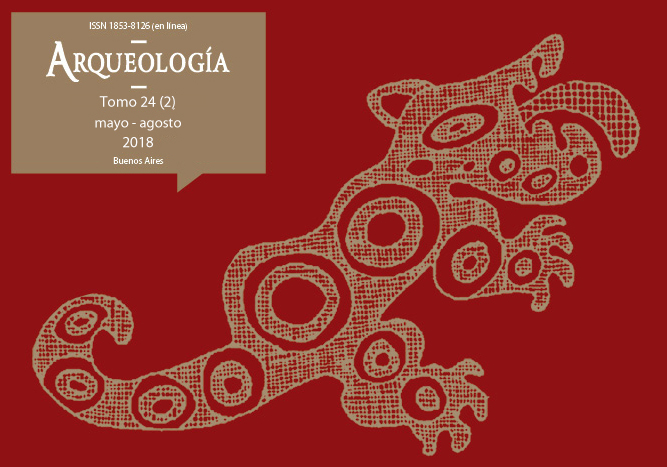Paisajes rupestres. La identificación de patrones de producción y distribución de arte parietal en escalas espaciales amplias (Cañadón Yaten Guajen, Santa Cruz, Patagonia argentina)
Palabras clave:
Arte rupestre, Paisaje, Escalas espaciales amplias, Agencia, Percepción, Movimiento
Resumen
En este trabajo se presenta una primera aproximación a la caracterización de los paisajes rupestres mediante la exploración y análisis sistemático del arte rupestre de dos sectores del cañadón Yaten Guajen (Santa Cruz, Patagonia Argentina). Dicho análisis se basa en la concepción de que los paisajes rupestres actualmente visibles son producto de las acciones acumuladas de grupos humanos cuyas agencias dejan señales en: a) la distribución de motivos en el soporte rocoso –identificables mediante el estudio de su frecuencia, proporción, densidad, expansión y variedad de motivos y de tipos de motivos– y b) el vínculo de los motivos entre sí y con el soporte. Para ello se propone una metodología de registro y un protocolo de análisis de datos rupestres a escalas espaciales amplias, combinando la noción de registro arqueológico como un continuum y la noción de que la experimentación de los paisajes rupestres requiere tanto percepción como movimiento y opera a distintas escalas espaciales complementarias. Los resultados se discuten a la luz del vínculo entre agencia de productores y observadores del arte, sugiriendo que los paisajes rupestres requieren no solo percepción visual sino también movimiento físico para poder experimentarlos.Descargas
La descarga de datos todavía no está disponible.
Cómo citar
Fiore, D., & Acevedo, A. (1). Paisajes rupestres. La identificación de patrones de producción y distribución de arte parietal en escalas espaciales amplias (Cañadón Yaten Guajen, Santa Cruz, Patagonia argentina). Arqueología, 24(2), 177-207. https://doi.org/10.34096/arqueologia.t24.n2.5006
Sección
Artículos
Los autores/as que publiquen en esta revista aceptan las siguientes condiciones:
- Los autores/as conservan los derechos de autor y ceden a la revista el derecho de la primera publicación, con el trabajo registrado mediante Licencia Creative Commons 4.0 Internacional (CC-BY-NC-SA), que permite a terceros utilizar lo publicado siempre que mencionen la autoría del trabajo y a la primera publicación en esta revista.
- Los autores/as pueden realizar otros acuerdos contractuales independientes y adicionales para la distribución no exclusiva de la versión del artículo publicado en esta revista (p.e. incluirlo en un repositorio institucional o publicarlo en un libro) siempre que indiquen claramente que el trabajo se publicó por primera vez en esta revista.
- Se permite y recomienda a los autores/as a publicar su trabajo en Internet (p.e. en sus sitios web personales o en depósitos institucionales), tanto antes como después de su publicación en esta revista, siempre y cuando proporcionen información bibliográfica que acredite, si procede, su publicación en ella. De esta manera, pueden favorecerse intercambios productivos y a una mayor y más rápida difusión del trabajo publicado (vea The Effect of Open Access).



.png)

(1)13.png)






1.jpg)
1.png)
1.jpg)


13.png)
1.png)


(1)1.png)









